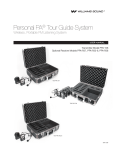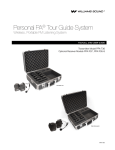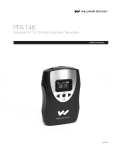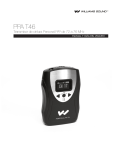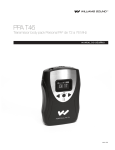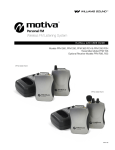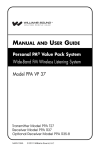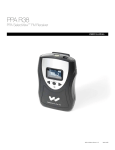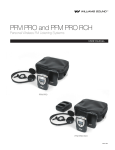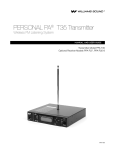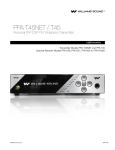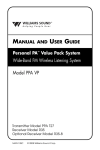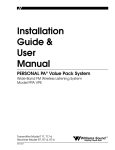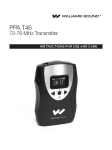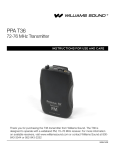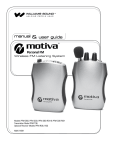Download Williams Sound TGS PRO 737 User manual
Transcript
Personal PA® Tour Guide System Wireless, Portable FM Listening System User MANUAL Transmitter Model PPA T46 Optional Receiver Models PPA R37, PPA R35-8 TGS PRO 737 TGS PRO MULTI MAN 158E PERSONAL PA® Tour Guide System PERSONAL PA® FM Tour Guide System TGS PRO 737, TGS PRO MULTI User Manual Contents System Overview................................................................................................................................................................ 3 System Components.......................................................................................................................................................... 3 Safety Information.............................................................................................................................................................. 4 Recycling Instructions....................................................................................................................................................... 4 72-76 MHz Wideband FM Transmitter............................................................................................................................ 4 PPA T46 Overview............................................................................................................................................................ 5 PPA T46 Features............................................................................................................................................................. 5 PPA T46 Included Parts.................................................................................................................................................... 5 PPA T46 Important Note about OLED care....................................................................................................................... 5 PPA T46 Quick Setup....................................................................................................................................................6-7 PPA T46 Basic Setup........................................................................................................................................................ 8 PPA T46 Advanced Setup............................................................................................................................................9-10 PPA T46 Dual-Preset Mode............................................................................................................................................. 10 Wideband FM Receivers................................................................................................................................................. 11 Receiver Model PPA R37................................................................................................................................................ 11 Operating the PPA R37 Receiver..................................................................................................................................... 11 LED Flash Codes............................................................................................................................................................ 11 Receiver Model PPA R35-8............................................................................................................................................. 12 Battery Installation........................................................................................................................................................... 12 Connecting Earphones and Headphones........................................................................................................................ 12 Operating the R35-8 Receiver......................................................................................................................................... 12 Receiver Belt Clip Removal/Installation............................................................................................................................ 13 Receiver Battery Information........................................................................................................................................... 14 Optional Battery Chargers.............................................................................................................................................. 15 Using the System.............................................................................................................................................................. 16 In Case Of Difficulty.......................................................................................................................................................... 16 Troubleshooting................................................................................................................................................................. 17 Lifetime PLUS Limited Warranty.................................................................................................................................... 18 System Specifications..................................................................................................................................................... 19 Personal PA® Transmitter, Model PPA T46..................................................................................................................... 19 PPA Select™ Receiver, Model PPA R37........................................................................................................................... 21 Personal PA® Recevier, Model PPA R35-8..................................................................................................................... 22 2 PERSONAL PA® Tour Guide System System Overview Thank you for purchasing the TGS PRO 737 or TGS PRO MULTI Personal PA® Tour Guide System from Williams Sound. The Personal PA® Tour Guide System is a portable, high-performance, wireless listening system. It is composed of a PPA T46 Transmitter, microphone, and optional PPA R37 or R35-8 receivers equipped with headphones or earphones. The system allows one-way transmission of a tour guide’s voice to group members using an FM radio signal. Using the system helps group members overcome background noise and distance from the person speaking. The Personal PA® Tour Guide System can be used for large or small tour groups, and in noisy or quiet environments. Your Personal PA® Tour Guide System has two principal parts: the transmitter and the receiver. Much like a miniature radio station, the transmitter and microphone pick up the sounds you want to hear and broadcast them over an FM radio signal. The receivers and headphones are used to pick up the broadcast up to 150 feet away. To avoid difficulties, please read through these instructions as you begin to use the system. Then save them for questions that arise as you continue to use your system. If you have problems with the Personal PA® Tour Guide System, don’t hesitate to call Williams Sound at 1-800-843-3544 or +1 952 943 2252. System Components • Body Pack Transmitter (PPA T46) with (2) AA batteries (BAT 001-2) and WCA 087 Auxillary Input Cable • Unidirectional headband microphone (MIC 100) • (10) Receivers (PPA R37 or R35-8) w/batteries (BAT 001-2) • Instruction manual • System carry case (CCS 030 S) Figure 1: How the Tour Guide System Works FM RADIO SIGNAL (CORD IS TRANSMITTING ANTENNA) TOUR GUIDE USES THE BODY PACK TRANSMITTER WITH MICROPHONE LISTENERS USE PERSONAL RECEIVERS WITH HEADPHONES, EARPHONES, OR NECKLOOP A314 3 PERSONAL PA® Tour Guide System Safety Information Hearing Safety: CAUTION! The tour guide system is designed to amplify sounds to a high volume level which could potentially cause hearing damage if used improperly. To protect your hearing and the hearing of others: 1. Make sure the volume on the receiver is turned down before putting on the earphone or headphone. Then adjust the volume to a comfortable level. 2. Set the volume level on the receiver at the minimum setting that you need to hear. 3. If you experience feedback with the receiver (a squealing or howling sound), reduce the volume setting and move away from the T46 transmitter’s microphone. 4. Do not allow children or other unauthorized persons access to the receiver. Battery Safety and Disposal: CAUTION! The transmitter and receiver may be supplied with alkaline batteries. Do not attempt to recharge alkaline batteries, which may explode, release dangerous chemicals, cause burns, or other serious harm to the user or product. Pacemaker Safety: CAUTION! 1. Before using this system with a pacemaker or other medical device, consult your physician or the manufacturer of your pacemaker or other medical device. 2. If you have a pacemaker or other medical device, make sure that you are using this product in accordance with safety guidelines established by your physician or the pacemaker manufacturer. Recycling Instructions Help Williams Sound protect the environment! Please take the time to dispose of your equipment properly. Product Recycling Instructions: Please do NOT dispose of your Williams Sound equipment in the household trash. Please take the equipment to an electronics recycling center; OR, return the product to the factory for proper disposal. Battery Recycling Instructions: Please do NOT dispose of used batteries in the household trash. Please take the batteries to a retail or community collection point for recycling. 4 PERSONAL PA® Tour Guide System 72-76 MHz Wideband Transmitter PPA T46 Overview PPA T46 Included Parts Much like a miniature radio station, the PPA T46 transmitter broadcasts over an FM radio signal. Receivers are used to pick up the broadcast up to 150 feet away. The system helps large or small groups overcome background noise and distance to clearly hear the speaker. (1) PPA T46 transmitter The PPA T46 FM transmitter broadcasts voice and/or audio programs on one of 17 available channels, 72-76 MHz. Listeners use PPA R35-8 / PPA R37 receivers equipped with headphones, earphones, or neckloops to hear the broadcast. (An R1600 speaker can also be used.) All items can be purchased separately. The PPA T46 features a convenient, dual preset mode that allows users to set separate channel/volume/auxiliary gain levels for each preset and then toggle back and forth between them. The OLED user interface on the PPA T46 is an easy-to-read digital display and active read-out. The unit also features flexible microphone and auxiliary inputs, push-button on/off/ mute controls, settings lock and selectable compression. To avoid difficulties, please read through these instructions, and keep them for reference. (1) BAT 001-2 AA batteries (1) WCA 087 auxiliary input cable Microphone sold separately. Note: The PPA T46 now replaces the PPA T36 transmitter in the Williams Sound Personal PA TGS PRO 737 and TGS PRO MULTI FM tour guide systems, and the FM ADA KIT 37 and FM ADA KIT 37 RCH compliance kits. Important Note about OLED Care The PPA T46 must be powered off before removing the batteries. Failure to do so may decrease the life of the OLED display. PPA T46 Features Sleek, ergonomic design Range of up to 150’ (with PPA R37 receiver) 1.25” OLED interface displays: · master volume level · channel/frequency · mic mute · settings lock · battery level · settings menus Accepts electret mic with 3.5mm mono plug or audio source (MP3, CD player) Belt clip for hands-free operation Made in the USA 17-channel selectable, wideband, 72-76 MHz Digitally synthesized frequencies Easy-to-use menu-access controls: · microphone and auxiliary levels · 8 or 17-channel mode selection · current frequency/channel number · compression (1:1 or 2:1) · display settings Lifetime PLUS Limited Warranty (90 days on accessories) Meets ADA Accessibility guidelines 5 PERSONAL PA® Tour Guide System 6.Select the desired operating frequency. Refer to the following channel selection chart. Make sure the transmitter and receiver channels match. Up to eight T46’s can operate simultaneously on different channels. If this is desired, set each T46 to 8-channel mode (see Advanced Settings, Step 4). The frequencies in 8-channel mode correspond to the R35-8 channel set shown in the chart. This preset eight channel/frequency selection is the only configuration that will allow simultaneous eight channel use. (FIG. C) (FIG. C) PPA T46 Quick Setup 1.Open the battery compartment. Slide the battery selection switch to the correct position for the type of batteries that will be used. Use “Alkaline” for non-rechargeable batteries, “NiMH” for rechargeable NiMH batteries (only). (FIG. A) IMPORTANT: If the battery switch is not in the correct position, damage may be caused to the unit. 2.Install the AA batteries. Be sure to observe proper polarity (+/-). Damage due to improper battery installation may void the warranty on the product. The battery icon on the display and the “Power On” LED on top of the unit will flash when the batteries are getting low; you may continue to use until the unit quits operating, then replace or recharge the batteries. (Figure. A) Figure C: Channel Selection Chart T46 Ch 1 2 3 4 5 6 7 8 9 10 11 12 13 14 15 16 17 3.Plug in the microphone cord (sold separately) using the “Mic Jack” on top of the transmitter (Figure B). Figure A: Battery Compartment ALKALINE/ NiMH SWITCH 4.Optionally, plug in a desired audio source such as a CD or MP3 player using the “Auxiliary Input” jack (WCA 087 stereo auxiliary input cable included). If mic and auxiliary sources are used together, the audio will be mixed. If only an auxiliary source is desired, the mic can be muted. Do not remove the mic from the “Mic Jack” as the microphone cable is also the transmitting antenna. (Figure B) A311 Letter A B O P I R G H C K N D E J S T F Freq (MHz) 72.1 72.3 72.6 72.8 74.7 75.4 75.7 75.9 72.5 72.2 72.4 72.7 72.9 75.3 75.6 75.8 75.5 R35-8 Ch 1 2 3 4 5 6 7 8 7.Change the transmitter to the desired channel. To access the channel setting, push the menu button until you see A376 the channel displayed. Change the channel by pushing the left or right arrow buttons. Push the menu button to save the channel. (Figure D, Figure E) Note: To choose by T46 FRONT frequency, see Advanced Settings. Figure D: Menu Buttons 5.Turn the unit on: press and hold the “ON/OFF/MUTE” button for three seconds. The “Power On” indicator will illuminate green. (Figure B) LEFT ARROW BUTTON T46 TOP Figure B: Top of Transmitter POWER ON/OFF, MUTE BUTTON MIC JACK 6 POWER "ON", LOW BATTERY LED AUXILIARY INPUT JACK A310 MENU BUTTON RIGHT ARROW BUTTON A309 PERSONAL PA® Tour Guide System Figure E: Menu Display MIC MUTED MIC + AUX AUDIO LEVEL TRANSMIT CHANNEL SETTINGS LOCKED BATTERY LIFE 8.To access additional settings, push the menu button A312 repeatedly until you see the setting you want. If no buttons are pushed, the screen will time-out and shut off. 9.To install the belt clip on the rear of the T46, position the belt clip on the back of transmitter. Turn the belt clip 180˚ left or right to secure the clip. The transmitter can now be clipped onto a belt. To remove, turn the belt clip 180˚ so the open end of the clip points up, and gently pull the belt clip off. (FIG. F) Figure F: Belt Clip Installation A119 10.Position the headset microphone boom as close to the speaker’s mouth as possible without actually touching. Lapel clip microphones should be attached to a collar or lapel, as close to the speaker’s mouth as possible. 11.When you pause from speaking, you may mute the microphone by pressing the “ON/OFF/MUTE” button once momentarily. The button will flash. The front display will also indicate the mic is muted. To unmute the mic, press the A119 button once momentarily again. Note: The AUX Audio Input is unaffected by the mic mute. 12. When the T46 transmitter is not being used, turn the unit OFF by pressing and holding the “ON/OFF/MUTE” button for three seconds. The Power On indicator will go off. 7 PERSONAL PA® Tour Guide System PPA T46 Basic Setup The Basic Setup Menu allows the user to change the most frequently used settings easily. The User can change the transmitting channel (or frequency), the master volume level, and the auxiliary volume level. 3. To set the transmit channel, push the menu button until you see the channel set screen, below. Use the arrow buttons to select one of the 17 channels (see Channel Selection Chart in Quick Setup, Fig. C). 1. Turn on the transmitter by pushing and holding the power button for 3 seconds. The transmitter will start up and show the following three screens. Note: While on the main screen, if the left or right arrow button is pushed, the following screen will show, indicating that you need to enter the menu in order to change any settings. 2. To mute the microphone, push and release the power button on the top of the transmitter. To un-mute, push and release the power button again. 8 4. To set the Master Volume Level (this is the microphone + auxiliary input volume), push the menu button until you see the master volume screen, below. Use the arrow buttons to adjust the volume level (1-30). 5. To set the Auxiliary Volume Level (this is the auxillary input volume before it is mixed with the microphone), push the menu button until you see the auxiliary volume screen, below. Use the arrow buttons to adjust the volume level (1-30). PERSONAL PA® Tour Guide System 6. To change the screen brightness (level 1-4), push the menu button until you see the brightness screen, below. Use the left, right arrow buttons to toggle between “1” “2” “3” or “4”. PPA T46 Advanced Setup The Advanced Setup Menu allows the user to turn compression on/ off, change between channel and frequency display mode, change the transmitter to 8 or 17-channel mode, change the amount of time for display time-out, set screen brightness, and restore factory default settings. 1. To access the Advanced Setup Menu, push the Menu button repeatedly to toggle through all of the basic settings, until you see the following screen. Push the right arrow to enter the advanced setup menu. 2. Audio Compression reduces the volume difference between loud and quiet sounds. To set the audio compression ratio, push the menu button until you see the compression screen, below. Use the left, right arrow buttons to toggle the compression (1:1 = compression off, and 2:1 = compression on). 4. 8-channel mode restricts the transmitter to just the 8 non-interfering (simulataneous broadcast) channels. To change the transmitter between 8-channel and 17-channel modes, push the menu button until you see the channel selection mode screen, below. Use the arrow buttons to toggle between “17 CHANNEL MODE” or “8 CHANNEL MODE”. 5. To change the display time-out period (5, 30, or 60 seconds), push the menu button until you see the time-out screen, below. Use the arrow buttons to toggle between “5 SECONDS” “30 SECONDS” or “60 SECONDS”. 7. To erase all user settings and return to factory defaults, push the menu button until you see the factory reset screen, “ERASE ALL SETTINGS RESTORE DEFAULTS?”, below. Push the right arrow button to choose “YES”. After this you will see the confirmation screen “FACTORY DEFAULTS RESTORED”. The transmitter will then return back to the main screen. 3. To change the display to show either frequency (72.1-75.9MHz) or channel number (1-17), push the menu button until you see the frequency display mode screen, below. Use the arrow buttons to toggle between “FREQUENCY” or “CH NUMBER” . 9 PERSONAL PA® Tour Guide System 8. To lock (or unlock) the settings, you must first be on the Main Screen. Then, push and hold the left- and right-arrow buttons together. While holding the buttons, you will see the following dashed-line display. Keep holding the buttons until all three lines disappear. The display will then show “PRESS MENU TO LOCK”. Push the Menu button. The display will then indicate “LOCKED”. To unlock the settings, follow these same steps in order. PPA T46 Dual-Preset Mode Dual-Preset Mode allows the user to instantly access one of two independent transmitting modes. Each preset can have it’s own frequency, master volume, and auxiliary volume settings. After setup, the user can easily toggle between the two presets. Note: only one frequency/channel can be transmitted at a time. 1. Turn the transmitter off by holding the power button for 3 seconds. The transmitter must be OFF before performing the next step. 6. Follow the steps under “Basic Setup” (starting at step 3) to set up each preset and “Advanced Setup” (starting at step 1) to change settings that affect both presets. 2. To access Dual-Preset Mode, push-and-hold the Power and Menu buttons together and keep holding them until you see the following screen “LOADING...” below. 7. To toggle between the two presets, exit out of the menu and use the arrow buttons to change between presets. 3. The T46 will power up in Dual-Preset Mode looking similar to the following screen. “P1” and “P2” indicate the two presets. The currently selected preset is surrounded by the box showing “ON AIR”. “ON AIR” means that this preset is currently transmitting. 4. Use the left or right arrow buttons to move the “ON AIR” box to the preset you want to adjust. (Note that you are now transmitting on this preset.) 10 5 . Push the Menu button and note that either “P1” or “P2” shows up on the top left corner of the screen. This indicates which Preset you are adjusting. Note: In Dual-Preset Mode, if settings are locked, the arrow buttons will allow you to toggle between presets, and the mic can be muted. All other settings are locked. PERSONAL PA® Tour Guide System Wideband FM Receivers Receiver Model PPA R37 The PPA R37 is a 17-channel receiver operating on the 72-76 MHz bandwidth. Features seek-button channel selection, channellock capability, battery-saving Sleep Mode, on/off volume control, power/low battery indicator, and stereo/mono earphone jack. Figure G: R37 Controls EARPHONE JACK OFF ON/OFF, VOLUME CONTROL SWITCH "ON" / LOW BATTERY/ FLASH CODE INDICATOR Operating the Receiver A116 1. Insert two (2) AA batteries ensuring correct polarity. If rechargeable NiMH batteries are to be used with the receiver and a Williams Sound charger, make sure the Alkaline/NiMH switch inside the battery compartment is set to NiMH before charging. See Figure H. 2. Insert the headphone, earphone or neckloop into the stereo output jack. 3. Turn receiver on by turning up the volume control. The green power LED will turn on. 4. Press the Channel Seek button inside the battery compartment once to seek an active transmitter. See Figure H. If more than one transmitter is being used, push the seek button additional times until you locate the signal you want to hear. The receiver will retain the channel setting when the unit is turned off. 5. To lock or unlock a selected channel, turn the power off. While holding the seek button, turn the power back on. When locked, the receiver will remain on the current channel regardless of channel seek button presses. Figure H: R37 Battery type and channel selection Channel Seek ALKALINE/ NiMH SWITCH – AA + + AA – LED Flash Codes CHANNEL SEEK BUTTON A117 Light Code Indicates Description 1 blink Channel locked Seek press remains on current channel 2 blinks Channel unlocked Seek press tunes to next channel present 3 blinks Channel unlocked; no other channels present Seek press attempts to find another channel On-Off-On-Off...(continuous) Batteries are low Batteries need to be replaced or recharged Fade-on, Fade-off... (continuous) No transmitter present on current channel Sleep/Power Save mode (extends battery life) 11 PERSONAL PA® Tour Guide System Receiver Model PPA R35-8 The PPA R35-8 is an eight channel receiver, operating on 72-76 MHz bandwidth. It features a channel selection knob, on/off volume control, LED power and low battery indicator, and an earphone jack (Figure I). Figure I: R35-8 Controls HEADPHONE JACK CHANNEL SELECTOR KNOB "ON"/LOW BATTERY INDICATOR ON/OFF, VOLUME CONTROL SWITCH Battery Installation A118 Make sure there are two alkaline or rechargeable AA batteries in the receiver. If batteries are not installed, see Battery Information on page 14. Connecting Earphones and Headphones Plug the earphone into the “Headphone/Earphone” jack on the top of the unit. Only monophonic earphones and headphones will operate properly. If stereo headphones are used, sound will be heard only in one side. Williams Sound evaluates each earphone and headphone sold with the PPA R35-8 receiver; we can only assure optimum performance when Williams Sound earphones and headphones are used. Operating the Receiver Turn the receiver on by rotating the Volume control knob. The ON indicator should illuminate RED. Set the channel to the same channel as the transmitter. Turn the channel selector knob to the desired channel. Adjust the volume to a comfortable listening level. To turn the receiver off, rotate the Volume control knob to the left until it clicks off. The ON indicator should not be lit. See Page 6, Figure C for R-35-8 frequency allocation. To prolong the battery life of the unit, turn the receiver off when it is not in use. 12 PERSONAL PA® Tour Guide System Belt Clip Removal/Installation To Install: Position the belt clip on the rear of the transmitter or receiver unit as shown in Figure J1. Turn the belt clip 180º left or right as shown in Figure J2. The belt clip is now installed and ready for use. To Remove: Turn the belt clip 180º so the edge points toward the top of the unit as shown in Figure J2. Gently pull the belt clip away from the unit to remove. Figure J1: R35-8 Belt Clip Installation Figure J2: Turn Belt Clip A119 13 PERSONAL PA® Tour Guide System Battery Information Installation/Removal Open the battery compartment by lifting the tab on the back of the transmitter or receiver with your finger. To remove depleted batteries, pull up on the fabric strip. (Figure K) IMPORTANT: If non-rechargeable batteries are being installed, slide the battery selection switch in the battery compartment to the “alkaline” position. See Figure K below. If installing NiMH (or rechargeable) batteries, slide the battery selection switch to the “NiMH” position. Figure K: R35-8 Battery Switch ALKALINE/ NiMH SWITCH A311 Press the batteries into place over the fabric strip. Be sure to observe proper polarity (+/-). Damage due to improper battery installation may void the warranty on the product. Power LED indicator will flash or turn red when the batteries are getting low (see Low Battery Indicator on chart below). Continue to use equipment until sound becomes weak or distorted, or until the equipment quits operating, then replace or recharge batteries. Do not leave dead batteries in the transmitter or receivers. The power indicator light may remain on, even with a battery that is weak. The chart below shows typical battery life with these units: Typical Battery Life Model PPA T46 PPA R37 PPA R35-8 Battery Type Battery Life Low Battery Indicator Power LED flashes Alkaline AA batteries (BAT 001-2) Up to 30 hours Rechargeable AA NiMH (BAT 026-2) Up to 20 hours Alkaline AA batteries (BAT 001-2) Up to 50 hours Rechargeable AA NiMH (BAT 026-2) Up to 32 hours Alkaline AA batteries (BAT 001-2) Up to 50 hours Rechargeable AA NiMH (BAT 026-2) Up to 32 hours Power LED flashes Power LED flashes !! IMPORTANT WARNINGS !! DO NOT ATTEMPT TO RECHARGE ZINC CARBON (“HEAVY DUTY”), ALKALINE, OR LITHIUM BATTERIES! DO NOT ATTEMPT TO RECHARGE SINGLE-USE BATTERIES! These batteries may heat up and explode, causing possible injury and damage to the equipment. Avoid shorting the plus and minus battery terminals together with metal objects. Battery damage and burns can result! Use only Williams Sound supplied chargers and rechargeable batteries! 14 PERSONAL PA® Tour Guide System Optional Battery Chargers Figure L1: CHG 3512 / 3512 PRO Multi-Charger CHG 3512 REAR VIEW RECEIVER OR TRANSMITTER DC POWER CHARGING INDICATOR A124 Figure L2: CHG 3502 Dual-Bay Charger RECEIVER OR TRANSMITTER CHARGING INDICATOR CHG 3502 REAR VIEW DC POWER CONNECTION A125 For more information on available chargers, visit www.williamssound.com or call +1 952 943 2252. 15 PERSONAL PA® Tour Guide System Using the System The nominal operating distance between the transmitter and receiver is about 150 feet. The operating range will vary in different buildings and surroundings. In some locations, the signal may momentarily disappear. This is called a “drop-out” and is due to reflection and cancellation of the radio signal. Moving a few feet should restore the signal. Keep the transmitter and receiver units at least 3 feet apart. If the transmitter gets too close to a receiver, it may overload the receiver, causing noisy reception or blocking of the signal. Do not use more than one transmitter on the same channel (frequency) at the same time unless they are physically separated by more than 200 feet. Operating more than one transmitter on the same channel at the same time in the same place will result in interference. Using Multiple Systems for Multiple Groups: For multiple tour groups within the same facility, multiple Tour Guide Systems may be operated on the same channel at the same time by maintaining physical separation of more than 200 feet between groups. The physical separation of groups takes advantage of the FM capture effect which causes receivers to lock onto the closest transmitter. Figure M: Tour Guide Group Separation TOUR GROUP 1 - CHANNEL 1 TOUR GROUP 2 - CHANNEL 1 200 ft A378 In Case Of Difficulty If your Tour Guide System is not working, check the following: 1. Read through the manual and user guide carefully to verify proper setup and installation of your system. 2. Make sure the batteries are fresh or completely charged and that the “plus” and “minus” terminals are installed correctly. 3. If the rechargeable batteries work for a short period of time (less than 1 hour) even after they are fully charged, they must be regenerated. Leave them in the receiver or transmitter with the unit turned on for 5 - 6 hours. Then turn receiver or transmitter off, place it in the charger, and fully charge the receiver and transmitter (refer to charger instruction manual). This should restore normal battery life. Rechargeable batteries will gradually lose their capacity over time and may need to be replaced every 1-2 years. 4. Make sure the microphone is plugged into the T46 Transmitter and the earphone or headphone is plugged into the PPA R37 or R35-8 Receiver. 5. Move the transmitter and receiver closer together. You may be out of range. When using the system indoors, it’s normal for the signal to momentarily disappear in certain locations. This is called a “drop-out.” Moving a few feet will restore the signal. 6. Do not try to use more than one transmitter on the same channel in close proximity to each other. MORE THAN ONE TRANSMITTER ON THE SAME CHANNEL WILL RESULT IN INTERFERENCE IF THEY ARE CLOSE TOGETHER. Keep the transmitters at least 200 feet apart or use separate channels for each system used. 7. If you are still hearing interference on the receivers, turn the transmitter off and listen with a receiver. If you hear the interference with the transmitter off, you need to change to a clear channel (see pages 8-9). Call your Williams Sound representative at 1-800-843-3544 or +1 952 943 2252 for details. 8. Make sure the transmitter and receiver(s) are on the same channel/frequency. 16 PERSONAL PA® Tour Guide System Troubleshooting Problem Solution Can’t hear the person speaking/no audio · Verify Transmitter and Receiver are both ON · Verify Transmitter and Receiver are both on the same channel/frequency. · Verify Transmitter mic is not muted. · Verify mic volume and aux volume levels - try turning them up. · Verify the microphone with cord is plugged in. The cord acts as the transmitting antenna. · If using the Aux input, verify the aux source is playing, and the level indicator (on the front of the transmitter) is pulsing. Can’t hear the person speaking above the room noise · Adjust the microphone volume in the menu Limited Range · The microphone cord is the transmitting antenna. Make sure it is not coiled up or obstructed, and that it is a Williams Sound approved mic. · Reposition the microphone closer to the mouth · Verify the transmitter distance from the receiver - try bringing them closer. · Verify there are no other transmitters in the area on the same (interfering) channels. · Transmitter batteries low? Receiver batteries low? Try new batteries and if this works, recycle the old ones. Feedback (squealing) · Lower the microphone volume in the menu · Increase the distance between the microphone and the listening speaker 17 PERSONAL PA® Tour Guide System System Specifications Personal PA® Transmitter, Model PPA T46 Dimensions: Weight: Color: Enclosure Material: Battery Type options: 4.1” L x 2.8” W x 1.1” D (104 mm x 71 mm x 28 mm) 2.6 oz (74 g), no batteries Black/Silver Shatter-resistant PC/ABS plastic with textured scratch-resistant aluminum faceplate Two (2) AA 1.5 V non-rechargeable Alkaline batteries (BAT 001-2), 75 mA nominal current drain, up to 30 hours battery life Two (2) AA 1.5 V NiMH rechargeable batteries (BAT 026-2), 75 mA nominal current drain, up to 20 hours battery life per charge, recharges in 14–16 hours, uses CHG 3502 or CHG 3512 Charger Operating Frequencies: Stability: Modulation: RF Output: Selectable, 17 channels, 72.1 – 75.9 MHz*. Switchable 8 or 17 Channel Mode. (8-channel mode setting corresponds with PPA R35-8 receiver channels) ± .005%, frequency synthesized, crystal reference, PLL Wide-band FM, 75 kHz peak, 75 µS pre-emphasis 80 mV/m at 3 m (max. allowed by FCC rules) Frequency Response: 180 Hz to 13 kHz, ± 3 dB at 1% max. THD Signal-to-Noise Ratio: 65 dB (typical) transmitted Transmit Antenna: Microphone: External Display: External Controls: External Indicators: Integral with microphone cord Electret type, 3.5 mm mono plug OLED for status and menu information. Status: Ch/Freq, Mic Audio Level, Auxiliary Input Audio Level, Battery Status, Mic Mute, Channel Lock, Dual-Preset mode. Menu: Ch/Freq display mode select, Volume, Aux Input, Compression, 17 or 8-channel mode, screen time out, screen brightness, restore default settings Momentary push button: push and hold 3 seconds for power On/Off, push and release for microphone mute On/Off. “Up”, “Down” and “Menu” buttons for accessing and changing transmitter settings. Battery type switch (Alkaline or NiMH) located behind the battery compartment door Power LED - Green, flashes when battery is low Mic Input: 3.5 mm mono jack with electret mic bias, adjustable gain with 25 dB range Aux Input: 2.5 mm stereo jack, adjustable gain with 60 dB range Audio Compression: Compatible Receivers: Approvals/Directives: Warranty: 1:1 (off) or 2:1 (on) selectable in menu PFM R31, PFM R32, PFM R33, PFM R36, PPA R35, PPA R37, PPA R35-8, PPA R1600, FCC, Industry Canada, RoHS, WEEE Lifetime PLUS Limited Warranty, 90 Days on most accessories. *DISCLAIMER: FCC RULES LIMIT USE OF THIS EQUIPMENT TO “AUDITORY ASSISTANCE.” NOTE: SPECIFICATIONS SUBJECT TO CHANGE WITHOUT NOTICE. This device complies to “RSS-Gen Issue 2 June 2007” for Industrie Canada and FCC part 15.105(b) for the United States. Operation is subject to the following two conditions: (1) this device may not cause interference, and (2) this device must accept any interference, including interference that may cause undesired operation of the device. This device complies with ICES-003 class B. Test data is available from the manufacturer on request. 18 PERSONAL PA® Tour Guide System PPA Select™ Receiver, Model PPA R37 Dimensions: Weight: Color: Battery Type: Battery Life: 4.1” x 2.85” x 1.38” (104 x 72 x 35mm) 4.6oz (130g) with batteries. 2.6oz (73g) without batteries Black (2) AA Alkaline or 2 x AA NiMH Two (2) AA non-rechargeable alkaline batteries (BAT 001-2), approx. 50 hrs (2) AA rechargeable NiMH batteries (BAT 026-2), 1500 mAh, approx. 32 hrs Current Consumption: Temperature Range: Channels Operating Freq.: 52mA nominal – 0 to 50C 17, accessed via seek button in battery compartment 72.1, 72.2, 72.3, 72.4, 72.5, 72.6, 72.7, 72.8, 72.9, 74.7, 75.3, 75.4, 75.5, 75.6, 75.7, 75.8, 75.9 MHz* Intermediate Freq.: 75 kHz FM Deviation: 75 kHz De-Emphasis: 75 µS LED Indicator: Power: Green; Low Battery: Flashes Green AFC Range: Sensitivity: Input Overload: Frequency Response: Modulation: Signal-to-Noise Ratio: Receive Antenna: ± 120 kHz 2 µV at 12 dB Sinad with squelch defeated 100 mV 200 – 15 kHz FM, +/- 75 kHz peak deviation 65 dB min @ 100 uV Integral with earphone/headphone cord Audio Output: 35 mW max, peak into 16 ohms Output Connector: 3.5 mm stereo/mono phone jack Earphone: Auto Shut-off Approvals: Warranty: Earbud-type with foam cushion, 3.5 mm plug, 32 Ω Enters sleep mode after approx 6 mins of no RF signal FCC, Industry Canada, RoHS, WEEE Lifetime PLUS Limited Warranty. 90 days on cords, earphones, headphones, batteries and other accessories *DISCLAIMER: FCC RULES LIMIT USE OF THIS EQUIPMENT TO “AUDITORY ASSISTANCE.” NOTE: SPECIFICATIONS SUBJECT TO CHANGE WITHOUT NOTICE. This device complies to “RSS-Gen Issue 2 June 2007” for Industrie Canada and FCC part 15.105(b) for the United States. Operation is subject to the following two conditions: (1) this device may not cause interference, and (2) this device must accept any interference, including interference that may cause undesired operation of the device. This device complies with ICES-003 class B. Test data is available from the manufacturer on request. 19 PERSONAL PA® Tour Guide System Personal PA® Receiver, Model PPA R35-8 Dimensions: Weight: Color: Battery Type: Current Consumption: Operating Freq: Intermediate Freq: 4.5” H x 2.85 W x 1.2” D (115 mm x 72 mm x 30 mm) 4.6 oz (130 g) Black Two (2) AA non-rechargeable alkaline batteries (BAT 001-2), approx. 50 hours battery life or Two (2) AA rechargeable NiMH batteries (BAT 026), 1400 mAh, approx 32 hours battery life Nominal 40 mA 72-76 MHz*: 8 channels: 72.1, 72.3, 72.6, 72.8, 74.7, 75.4, 75.7, or 75.9 MHz. 10.7 MHz FM Deviation: +/- 75 kHz De-emphasis: 75 uS LED Indicator: Power: Red. Low Battery: Flashes Sensitivity: Input Overload: Frequency Response: Signal to Noise ratio: Receive Antenna: 2 uV at 12 dB SINAD with squelch defeated 20 mV 40 Hz to 15 kHz +/- 3 dB 60 dB at 100 uV Integral with earphone/headphone cord Audio Output: 35 mW, max 16 ohm load Output Connector: 3.5 mm mono phone jack Squelch: Notes: Approvals: Warranty: Located inside battery door. Factory set for 25 dB S/N. Squelch may be set with JFD-7104-5 from Sprague Goodman or any flat tipped tuning tool with tip size .095 X .016 The R35-8 is NOT field tunable. The eight channels have been carefully selected to inhibit inter-modulation interference. FCC, Industry Canada, RoHS, WEEE Lifetime PLUS Limited Warranty. 90 days on cords, earphones, headphones, batteries, and other accessories *DISCLAIMER: FCC RULES LIMIT USE OF THIS EQUIPMENT TO “AUDITORY ASSISTANCE.” NOTE: SPECIFICATIONS SUBJECT TO CHANGE WITHOUT NOTICE. 20 PERSONAL PA® Tour Guide System Lifetime PLUS Limited Warranty Williams Sound products are engineered, designed, and manufactured under carefully controlled conditions to provide you with many years of reliable service. Effective January 1, 2012, Williams Sound warrants the Personal PA® FM Listening transmitters and receivers (models PPA T35, PPA T27, PPA T46, PPA R37, and PPA R35-8) against defects in materials and workmanship under normal use and conditions for the useful lifetime of the product from date of purchase. This warranty is available to the original end purchaser of the product and CAN BE transferred to subsequent purchasers of the product. Microphones, earphones, headphones, rechargeable batteries, chargers, cables, carry cases, and most other accessory products carry a 90-day warranty. Williams Sound has no control over the conditions under which this product is used. Williams Sound, therefore, disclaims all warranties not set forth above, both express and implied, with respect to the Personal PA® FM Listening System, including but not limited to, any implied warranty of merchantability or fitness of use of such equipment including, without limitation, any warranty that the use of such equipment for any purpose will comply with applicable laws and regulations. Williams Sound shall not be liable to any person or entity for any medical expenses or any direct, incidental or consequential damages caused by any use, defect, failure or malfunctioning of the product, whether a claim for such damages is based upon warranty, contract, tort or otherwise, the sole remedy for any defect, failure or malfunction of the products is replacement of the product. No person has any authority to bind Williams Sound to any representation or warranty with respect to the Personal PA® FM Listening System. Unauthorized repairs or modifications will void the warranty. This warranty is void if damage occurred because of misuse, or if the product has been repaired or modified by anyone other than a factory authorized service technician. Warranty does not cover normal wear and tear on the product or any other physical damage unless the damage was the result of a manufacturing defect. Williams Sound is not liable for consequential damages due to any failure of equipment to perform as intended. Williams Sound shall bear no responsibility or obligation with respect to the manner of use of any equipment sold by it. This warranty does not cover reimbursement for your costs of removing and transporting the product for warranty service evaluation or installation of any replacement product provided under this warranty. The exclusions and limitations set out above are not intended to, and should not be construed so as to contravene mandatory provisions of applicable law. If any part or term of this Disclaimer of Warranty is held to be illegal, unenforceable, or in conflict with applicable law by a court of competent jurisdiction, the validity of the remaining portions of this Disclaimer of Warranty shall not be affected, and all rights and obligations shall be construed and enforced as if this Limited Warranty did not contain the particular part or term held to be invalid. The terms of the warranty are governed by the laws of the State of Minnesota. Prices and the specifications of the products are subject to change without notice. *For Complete Warranty Statement go to: www.williamssound.com/warranty-statement If you experience difficulty with your system, call Toll-Free for customer assistance: 1-800-843-3544 (U.S.A.) or +1 952 943 2252 (Outside the U.S.A.) If it is necessary to return the system for service, your Customer Service Representative will give you a Return Authorization Number (RA) and shipping instructions. Pack the system carefully and send it to: Williams Sound Attn: Repair Dept. 10300 Valley View Road Eden Prairie, MN 55344 USA 21 PERSONAL PA® Tour Guide System 10300 Valley View Rd • Eden Prairie, MN 55344 800-328-6190 / 952-943-2252 • FAX: 952-943-2174 www.williamssound.com ©2013 Williams Sound, LLC • All Rights Reserved MAN 158E






















